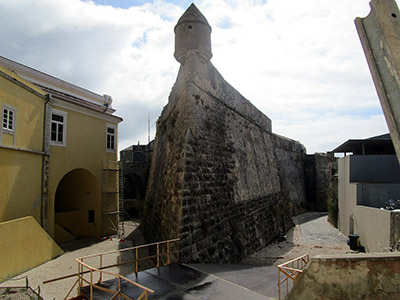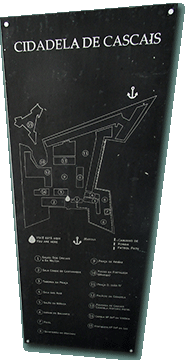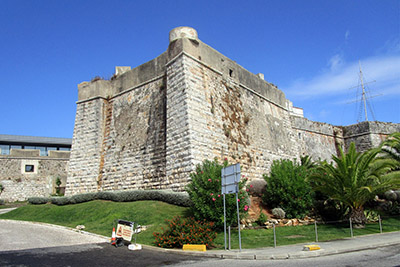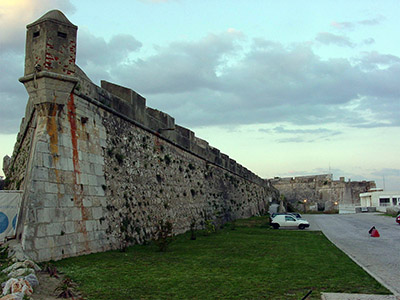 |
Cidadela de Cascais
Cascais, Portugal
|
|
 |
Constructed: 1594-1760?
Used by: Spain, Portugal
Conflicts in which it participated:
None
|
There are big starforts, there are little starforts. There are very few starforts that are both big and little, with one bastion that is...a starfort.
Monte de Casais, a "mountain of shells," was how the city of Cascais got its name. As a provider of seafood for Lisbon, great mounds of mollusk shells were the most scenic attribute in the medieval version of the city of our current interest (which is Cascais).
|
 |
|
|
"Cascale," as the town was known until everybody figured out the proper way to spell it, had its own castle by 1370, but even the most lovely castle doesn't do much to prevent seaborne invasion, and the little town was a frequent target for piratical activity. Portugal's Age of Discovery, which began with the conquest and colonization of Ceuta in 1415, not only generated much riches for the Portuguese crown, but was also the source of much enmity from other seafaring European nations. At the very dawn of this era, a battery was built at Cascais, part of a number of new defenses for the port of Lisbon. An "artillery ship" also patrolled the mouth of the Tagus River, which was the aquatic highway that connected Portugal's capital city to the ocean. |
 Cascale, complete with medieval-style city walls, around 1500. The Torre de Santo António de Cascais, looking suspiciously like a church, is in the foreground. Cascale, complete with medieval-style city walls, around 1500. The Torre de Santo António de Cascais, looking suspiciously like a church, is in the foreground. |
 |
The Torre de Santo António de Cascais (alternately known as the Baluarte de Cascais) was built from 1488 to 1505. Though a starfort enthusiast might hear the word "tower" and yawn, the Torre was indeed a fortification: Three levels, two cisterns, four garitas and vaulted ceilings made this torre a fort, albeit a vertically-oriented one. The Torre would have been armed with whatever ridiculous little cannon were available at the time, and the security provided by this new structure allowed Cascais to grow into a city. The Torre and two other similar structures were the brainchild of Portugal's King John II (1455-1495), who had an interest in further defending Lisbon's watery approaches. The bedrock of Portugal's aristocracy was shaken by the death of King Sebastian I (1554-1578), who perished in an heroic fashion whilst fighting the Moors in Morocco. |
 |
|
Não é um problema, said Cardinal Henry (1512-1580), who had been acting as regent for his grand-nephew King Sebastian. Henry leapt onto the throne, but he was known as Henry the Chaste, having spent most of his life as a Roman Catholic Cardinal, and thus had no offspring to continue the dynasty. Henry denounced his religious office and signed up with a bunch of online dating services to begin the procreation process as quickly as possible, but the Internet was a chancy thing in the late 16th century, and he died before he could proliferate.
|
All of which worked out quite nicely for Spain's King Phillip II (1527-1598), who happened to have a dubious claim to Portugal's throne. Phillip galloped over a few other Portuguese claimants, declared himself king of Portugal, and found some members of Portugal's Council of Governors to back him up.
Phillip did not scoop up Portugal without a fight. The Torre de Santo António de Cascais was reinforced around 1580, in expectation of a Spanish invasion. The torre was surrounded with a wall (making it look suspiciously like a church in contemporary depictions) and provided with more ammunition, men and artillery. None of which made any difference: Fadrique Álvarez de Toledo (1537-1583), the 4th Duke of Alba and commander of Spain's armed forces, made relatively short work of all opposition.
|
 |
 I cannot express how pleased I am to have a friend who travels in Europe and takes pictures of starforts for me. This shot, of the Fortelezza within the greater Citadel, comes to us courtesy of Peter Presford of Postern magazine. I cannot express how pleased I am to have a friend who travels in Europe and takes pictures of starforts for me. This shot, of the Fortelezza within the greater Citadel, comes to us courtesy of Peter Presford of Postern magazine. |
|
The Iberian Union made Portugal a vassal state of Spain from 1580 until 1640. While Portugal remained technically in charge of its overseas holdings (of which there were many) and at least notionally in charge of its own affairs, Spain's King Phillip II and the next couple of Phillips were really running things. Portugal's position as a global power was greatly damaged by this arrangement: Spain dragged Portugal into its endless conflict with the Dutch in the 80 Years' War (1568-1648), resulting in the loss of many of Portugal's far-flung settlements and commercial enterprises in Africa, the Far East and India to the Dutch.
Plans had been made to further fortify the Cascais area prior to the Union, but after 1580 protection of Lisbon (from Spain) was no longer necessary (because of Spain)...
|
 Thanks again, Mr. Presford! Click it to see it big enough to see it. Thanks again, Mr. Presford! Click it to see it big enough to see it. |
 |
...or was it? In 1594 work began on the Forte de Nossa Senhora da Luz de Cascais, or Fort of Our Lady of Light of Cascais. Part of a sweeping Spanish plan to turn the Tagus River leading to Lisbon into a heavily-armed powerhouse of defensive fortification, it was designed by an Italian by the name of Captain Fratino. The Torre was surrounded with three triangular bastions, and finally we're talking about a starfort! Even though the Spanish had built Portugal a lovely new starfort at Cascais, the Portuguese were still unhappy with Spanish rule, and the process of restoring Portugal to the Portuguese began with a revolt in 1640. The Portuguese Restoration War (1640-1668) featured some very satisfying starfort action, including several unsuccessful Spanish attempts to capture the spectacularly fortified city of Elvas. Construction of the Citadel of Cascais began in 1648, at the order of Portugal's King John IV (1604-1656): Portugal was officially back in the needing-to-defend-Lisbon-from-Spain game! The Citadel must have worked, because 1668's Treaty of Lisbon ended 28 years of conflict, and Portugal was back in charge of itself. Things chugged right along for Cascais, Portugal and its colonies until 9:40am on November 1, 1755, when a huge earthquake, followed by an equally huge tidal wave, almost completely flattened Lisbon. |
|
This disaster killed 30,000-60,000 people in Lisbon and effectively put Portugal's colonial ambitions on hold for much of the rest of the 18th century, but more importantly to our current interest it severely damaged the Citadel of Cascais. Cracks were opened in its walls, the roof of the old Torre at the center of the Forte de Nossa Senhora da Luz collapsed (taking with it all the tower's inner floors and ceilings) and, perhaps most tragically, a chapel for St. Anthony, the patron saint of Portugal's army (and namesake of the Torre), was destroyed.
|
Repairs were duly made to the fortlet and its surrounding Citadel. As the needs of a modern military surpassed starforts in the 19th century, a new role was found for the Cidadela de Cascais: Summer home to the Portuguese royal family! Beginning in 1870, Portugal's King Luís I (1838-1889) (The Popular) and his family (The Irritating) spent their summers at the Citadel, which proved to be far enough away from Lisbon to represent a vacation, yet close enough to not really be a vacation. In 1878, the Citadel complex were the first buildings in Portugal to be wired up with electric lights.
Royal Summer Home continued to be the Cidadela de Cascais' primary function until 1910, when the monarchy was abolished thanks to a coup d'état by the Portuguese Republican Party.
|
 |
 The rather slab-sided southern bastion of the Forte de Nossa Senhora da Luz de Cascais. The rather slab-sided southern bastion of the Forte de Nossa Senhora da Luz de Cascais. |
|
After four decades of housing monarchs, the Citadel was surely a plushy pad by 1910, and somebody important must have spent time there, but sources are quiet regarding the Citadel's doings through most of Portugal's turbulent 20th century. In 1977 the Citadel was classified as a Property of Public Interest, and in 1985 a serious restoration process began.
|
 The Citadel's southernmost bastion, featuring a big honkin' garita. The Citadel's southernmost bastion, featuring a big honkin' garita. |
 |
One restored, the Citadel was a lovely tourist attraction, but also a very large space to maintain for such a purpose. In the early 21st century the Citadel was ceded to the City Council of Cascais, which body wisely sought private investment... resulting in a 126-room luxury hotel opening therein, in 2012.
2014 brought with it the christening of the Cidadela Art District. This opened the Citadel's empty spaces for "cultural galleries," exhibition locations and studios for both artists and visitors. This enterprise was meant to bring contemporary art to the public through the "appropriation of unconventional spaces and media associated with mass communication." Thanks for clarifying that so unclearly, Cidadela Art District.
|
|
|
|
|
|
|
 |




